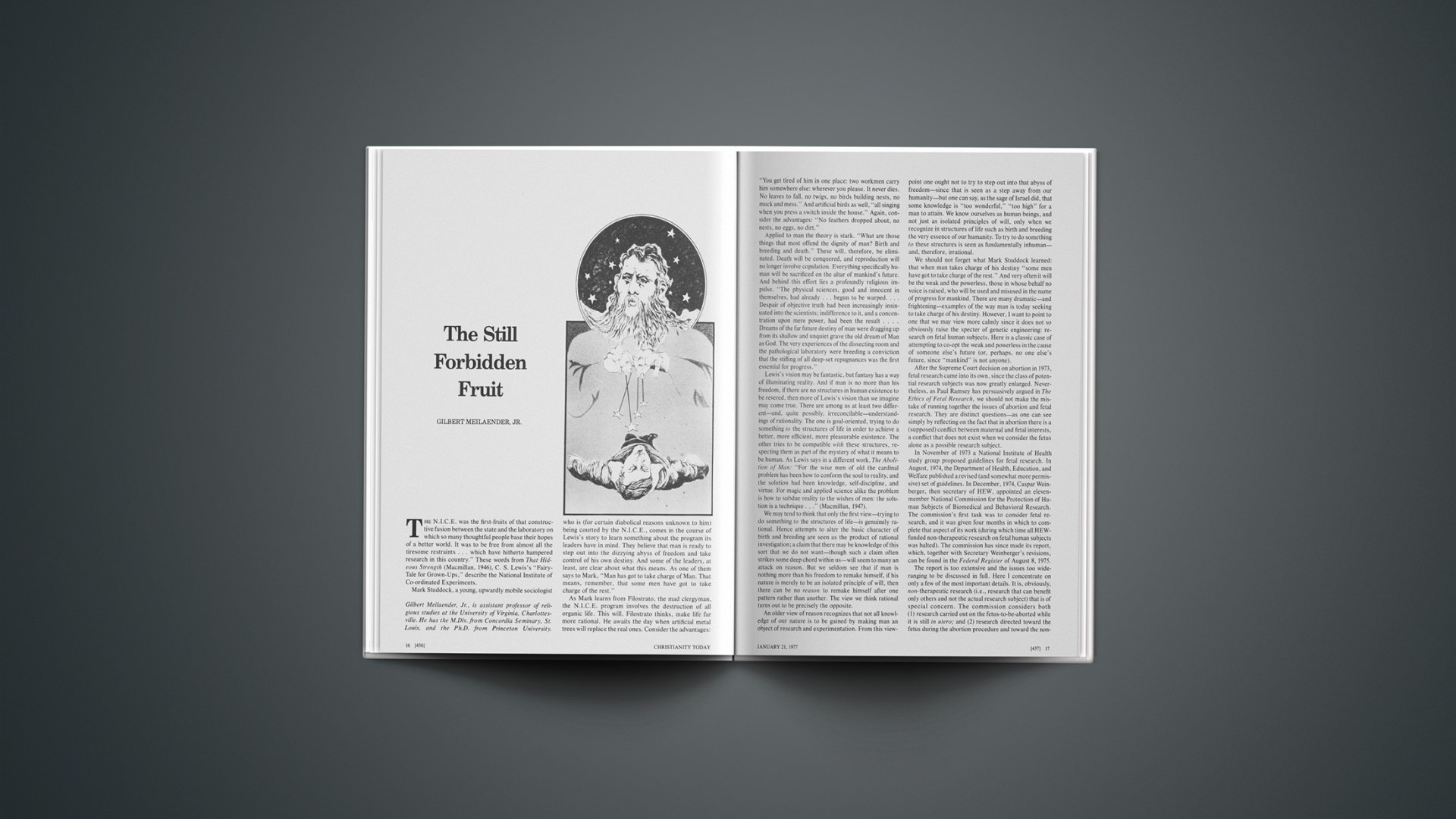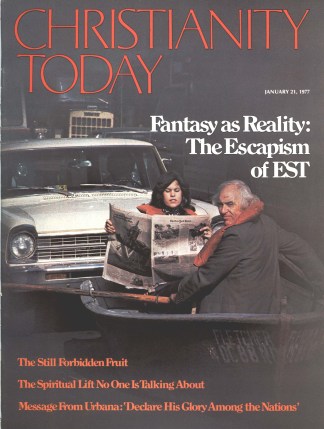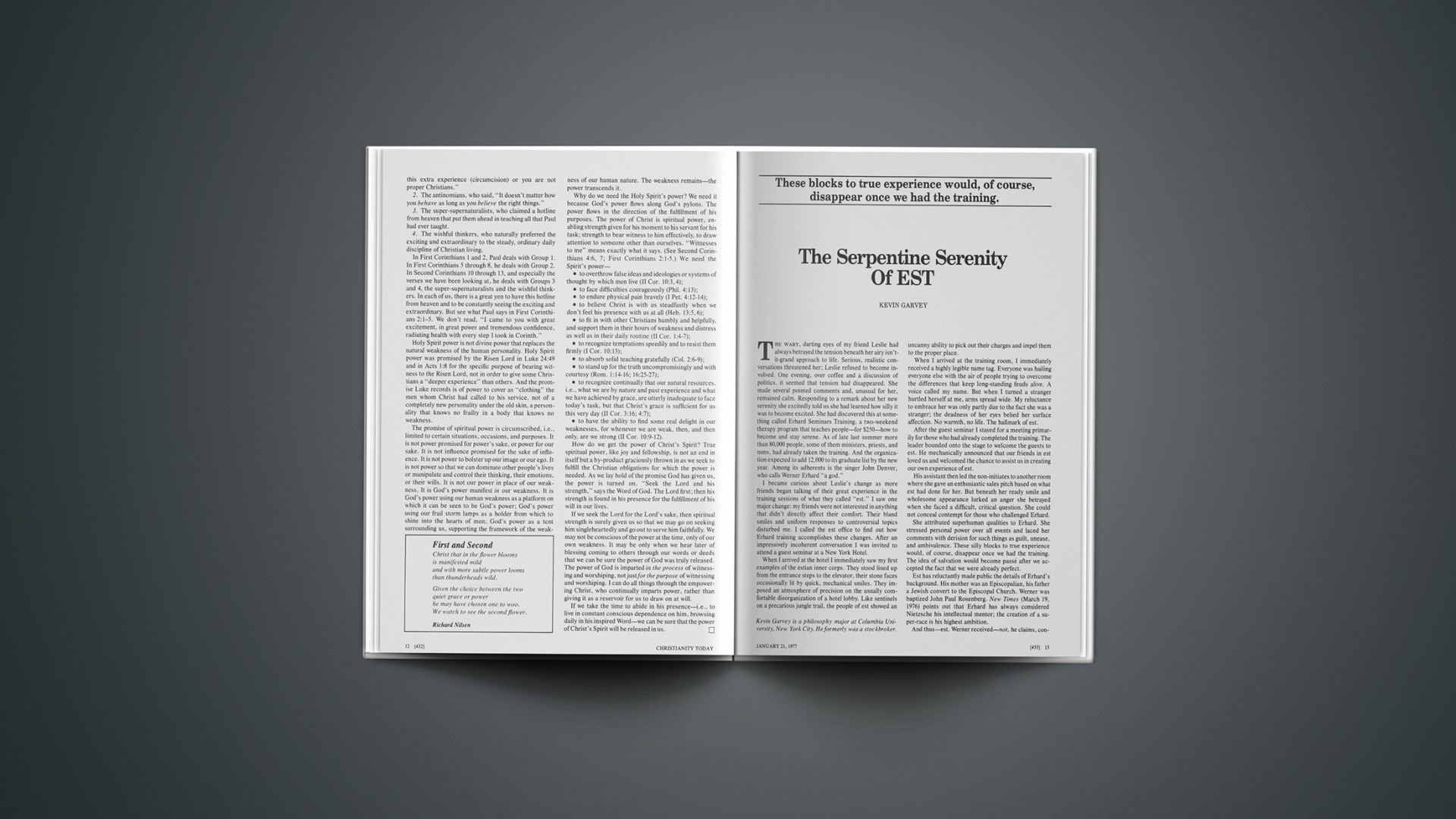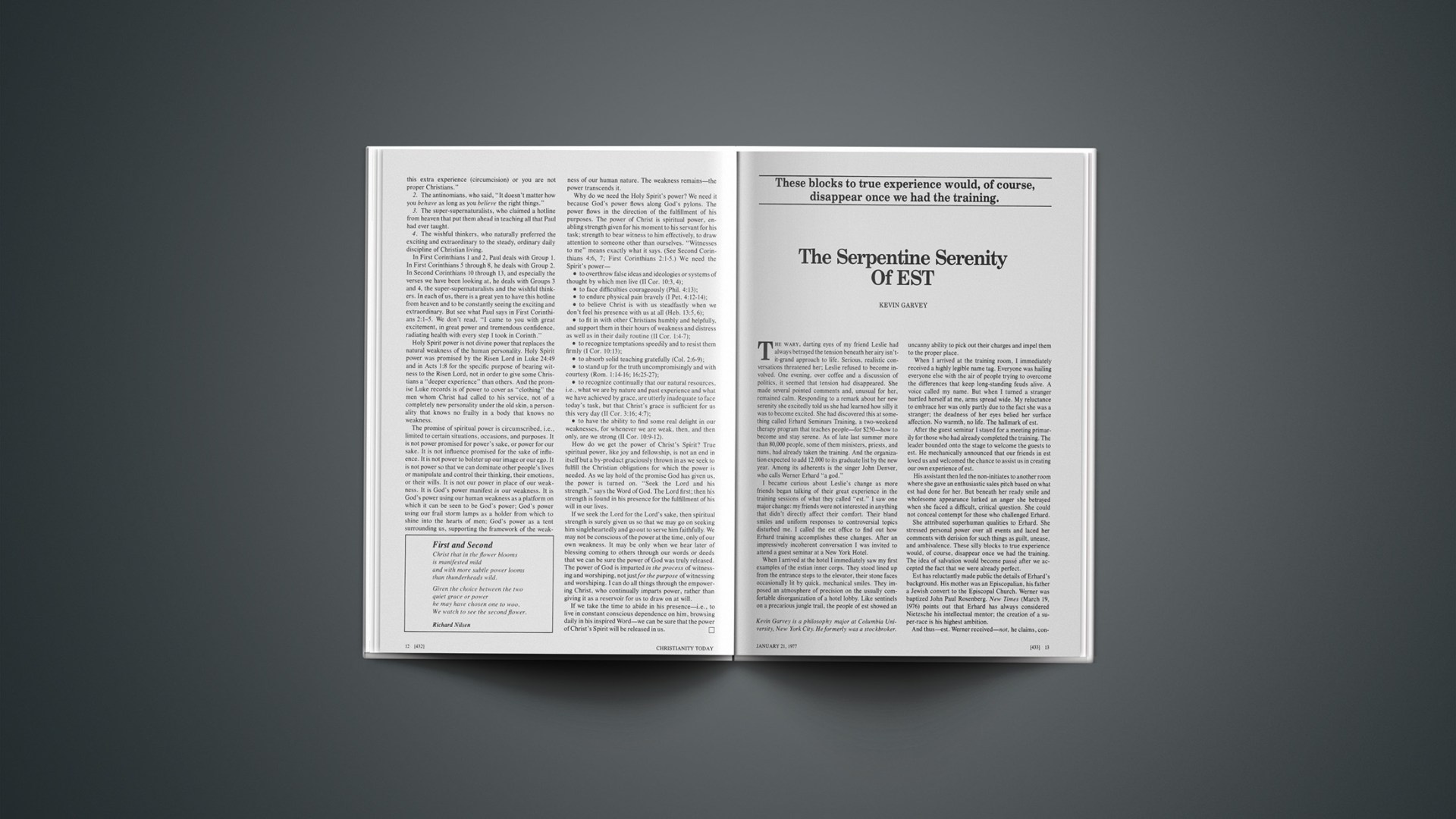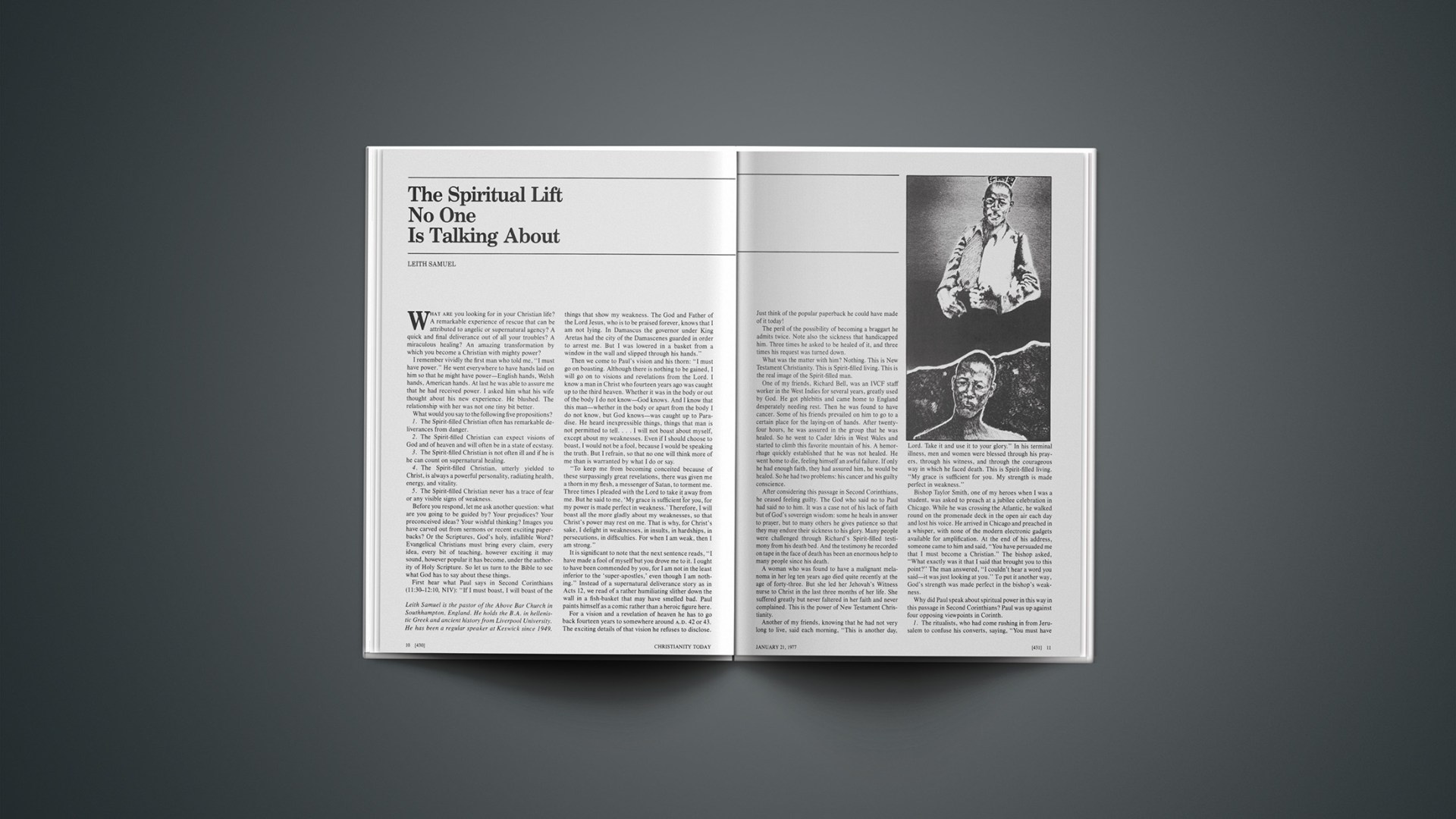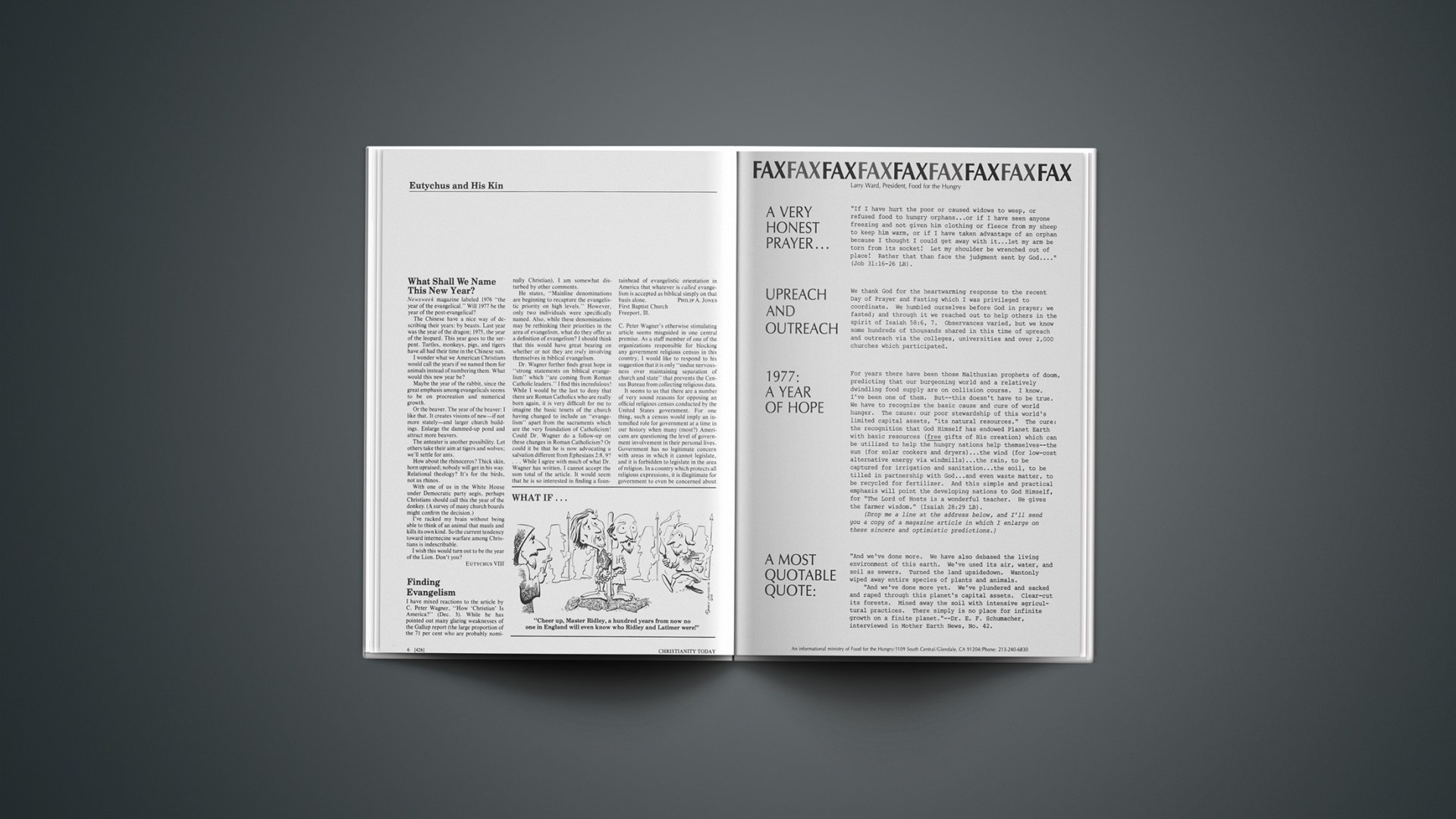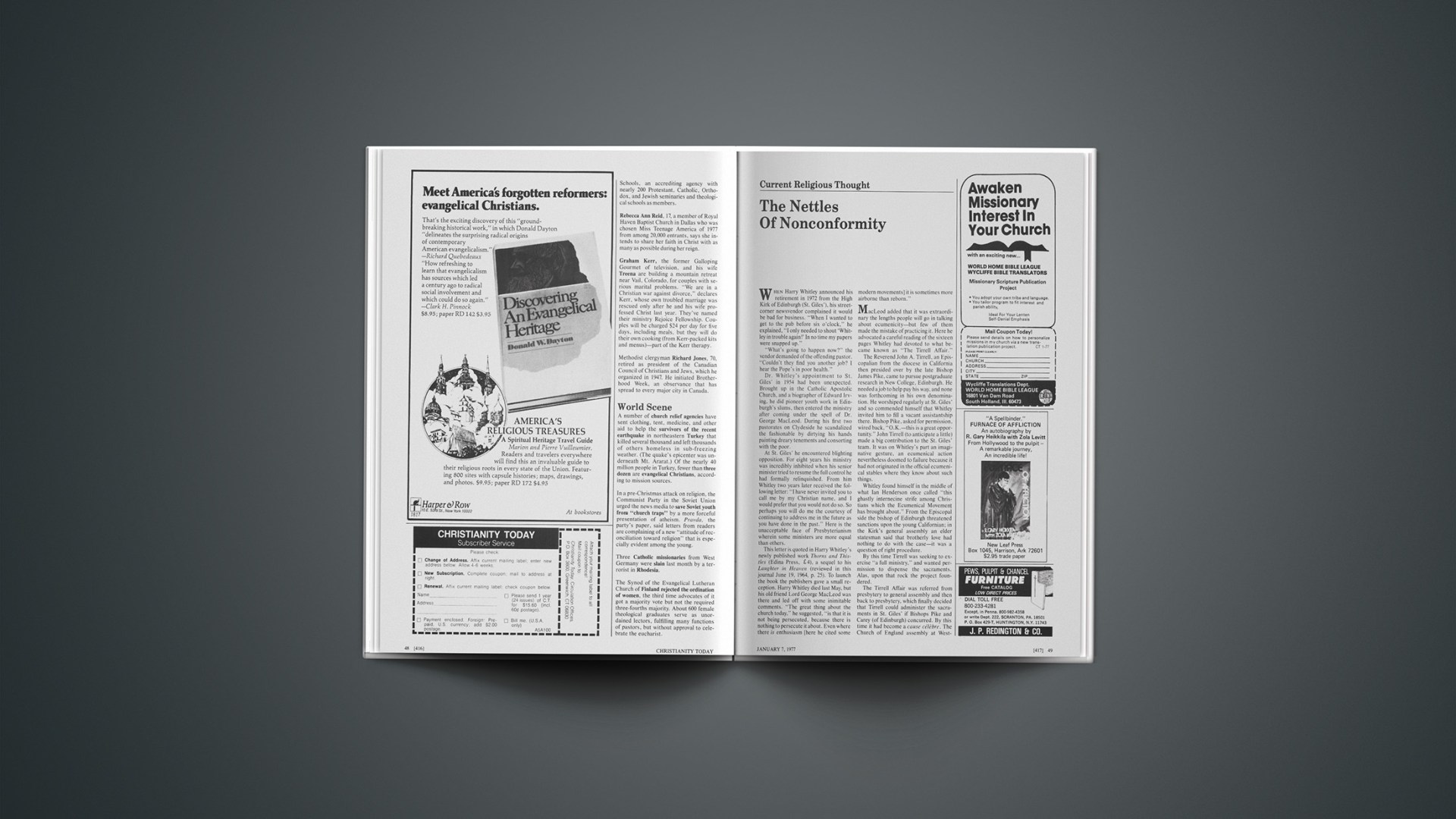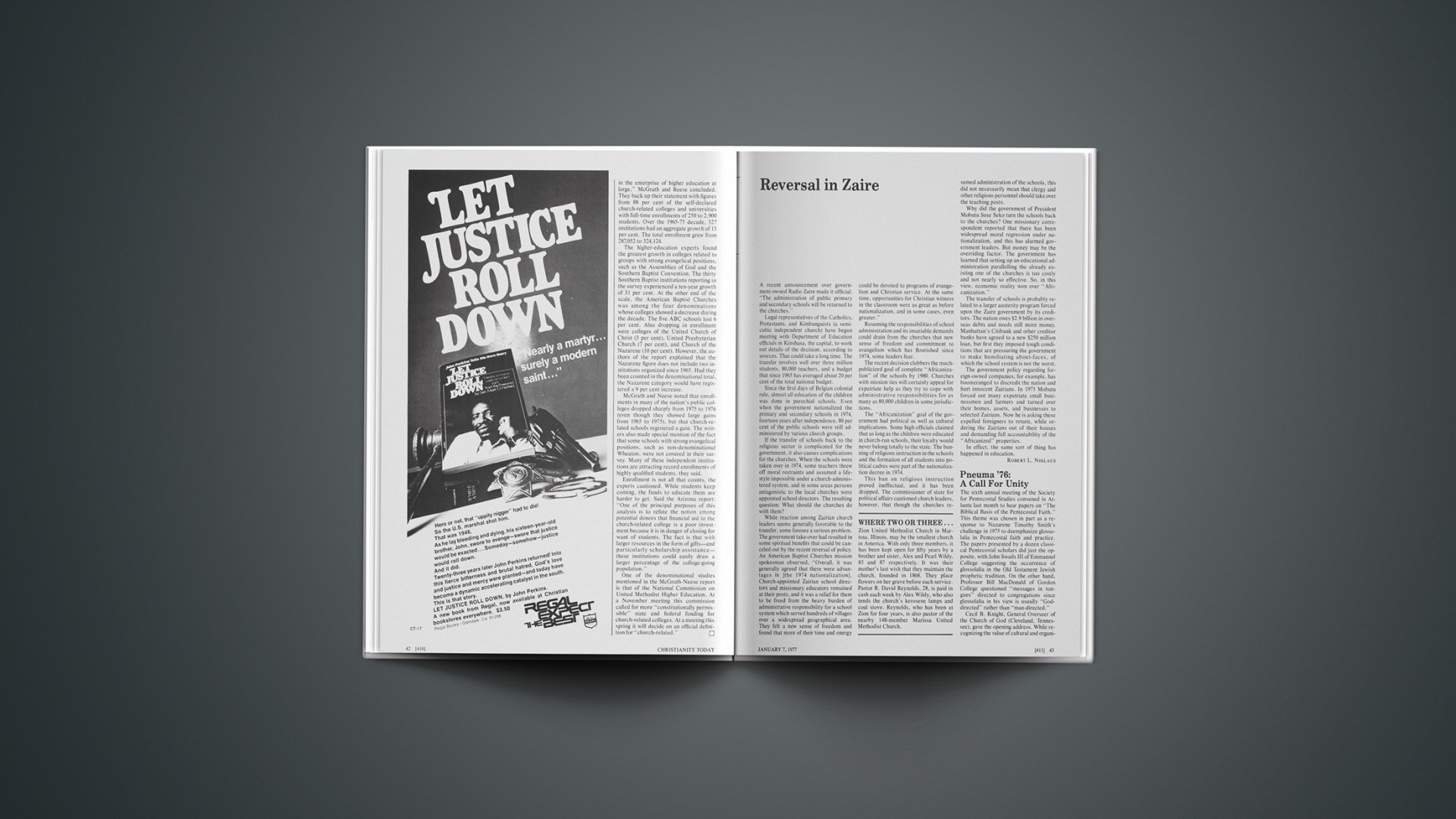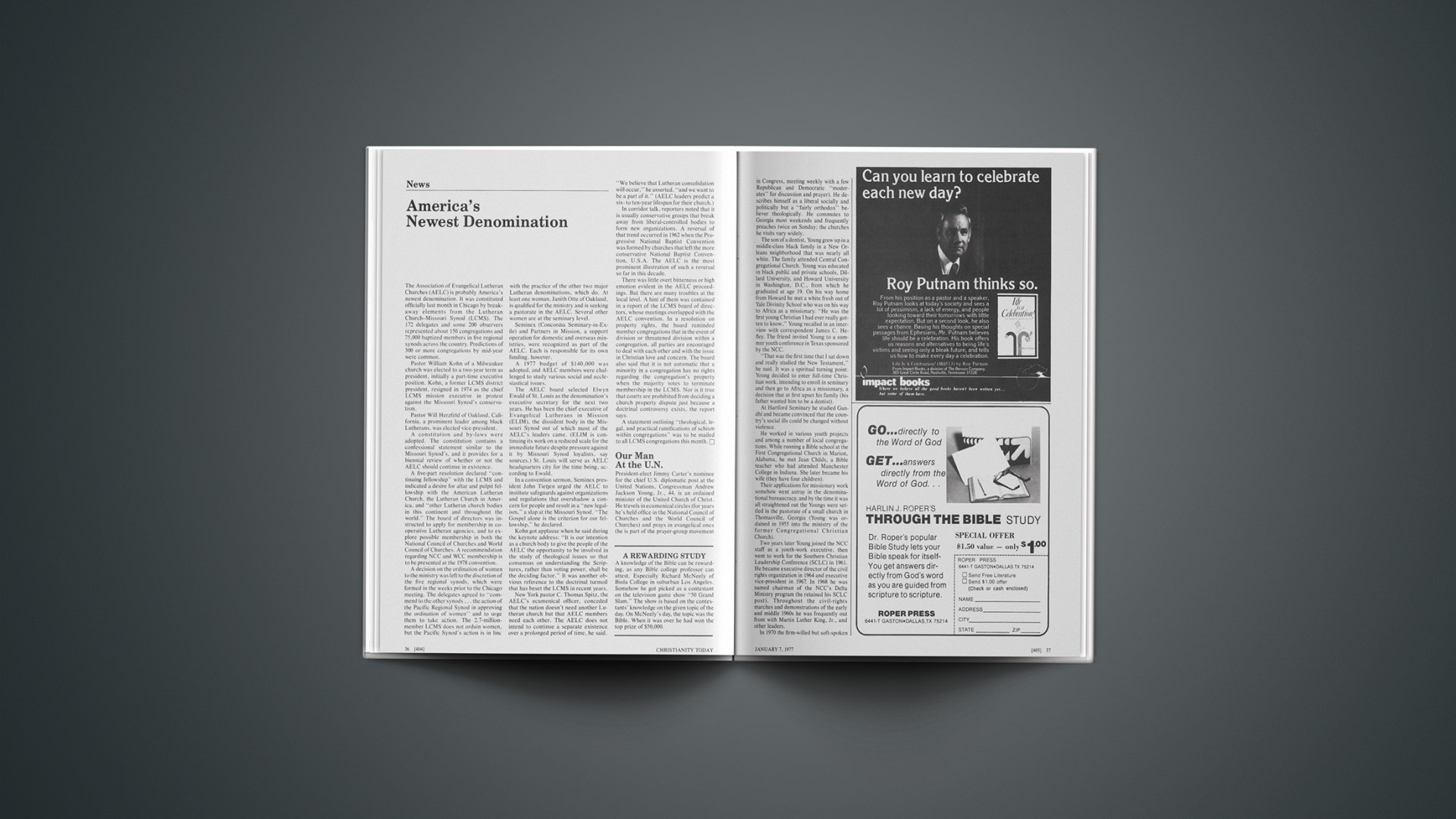The N.I.C.E. was the first-fruits of that constructive fusion between the state and the laboratory on which so many thoughtful people base their hopes of a better world. It was to be free from almost all the tiresome restraints … which have hitherto hampered research in this country.” These words from That Hideous Strength (Macmillan, 1946), C. S. Lewis’s “Fairy-Tale for Grown-Ups,” describe the National Institute of Co-ordinated Experiments.
Mark Studdock, a young, upwardly mobile sociologist who is (for certain diabolical reasons unknown to him) being courted by the N.I.C.E., comes in the course of Lewis’s story to learn something about the program its leaders have in mind. They believe that man is ready to step out into the dizzying abyss of freedom and take control of his own destiny. And some of the leaders, at least, are clear about what this means. As one of them says to Mark, “Man has got to take charge of Man. That means, remember, that some men have got to take charge of the rest.”
As Mark learns from Filostrato, the mad clergyman, the N.I.C.E. program involves the destruction of all organic life. This will, Filostrato thinks, make life far more rational. He awaits the day when artificial metal trees will replace the real ones. Consider the advantages: “You get tired of him in one place: two workmen carry him somewhere else: wherever you please. It never dies. No leaves to fall, no twigs, no birds building nests, no muck and mess.” And artificial birds as well, “all singing when you press a switch inside the house.” Again, consider the advantages: “No feathers dropped about, no nests, no eggs, no dirt.”
Applied to man the theory is stark. “What are those things that most offend the dignity of man? Birth and breeding and death.” These will, therefore, be eliminated. Death will be conquered, and reproduction will no longer involve copulation. Everything specifically human will be sacrificed on the altar of mankind’s future. And behind this effort lies a profoundly religious impulse. “The physical sciences, good and innocent in themselves, had already … begun to be warped.… Despair of objective truth had been increasingly insinuated into the scientists; indifference to it, and a concentration upon mere power, had been the result.… Dreams of the far future destiny of man were dragging up from its shallow and unquiet grave the old dream of Man as God. The very experiences of the dissecting room and the pathological laboratory were breeding a conviction that the stifling of all deep-set repugnances was the first essential for progress.”
Lewis’s vision may be fantastic, but fantasy has a way of illuminating reality. And if man is no more than his freedom, if there are no structures in human existence to be revered, then more of Lewis’s vision than we imagine may come true. There are among us at least two different—and, quite possibly, irreconcilable—understandings of rationality. The one is goal-oriented, trying to do something to the structures of life in order to achieve a better, more efficient, more pleasurable existence. The other tries to be compatible with these structures, respecting them as part of the mystery of what it means to be human. As Lewis says in a different work, The Abolition of Man: “For the wise men of old the cardinal problem has been how to conform the soul to reality, and the solution had been knowledge, self-discipline, and virtue. For magic and applied science alike the problem is how to subdue reality to the wishes of men: the solution is a technique …” (Macmillan, 1947).
We may tend to think that only the first view—trying to do something to the structures of life—is genuinely rational. Hence attempts to alter the basic character of birth and breeding are seen as the product of rational investigation; a claim that there may be knowledge of this sort that we do not want—though such a claim often strikes some deep chord within us—will seem to many an attack on reason. But we seldom see that if man is nothing more than his freedom to remake himself, if his nature is merely to be an isolated principle of will, then there can be no reason to remake himself after one pattern rather than another. The view we think rational turns out to be precisely the opposite.
An older view of reason recognizes that not all knowledge of our nature is to be gained by making man an object of research and experimentation. From this viewpoint one ought not to try to step out into that abyss of freedom—since that is seen as a step away from our humanity—but one can say, as the sage of Israel did, that some knowledge is “too wonderful,” “too high” for a man to attain. We know ourselves as human beings, and not just as isolated principles of will, only when we recognize in structures of life such as birth and breeding the very essence of our humanity. To try to do something to these structures is seen as fundamentally inhuman—and, therefore, irrational.
We should not forget what Mark Studdock learned: that when man takes charge of his destiny “some men have got to take charge of the rest.” And very often it will be the weak and the powerless, those in whose behalf no voice is raised, who will be used and misused in the name of progress for mankind. There are many dramatic—and frightening—examples of the way man is today seeking to take charge of his destiny. However, I want to point to one that we may view more calmly since it does not so obviously raise the specter of genetic engineering: research on fetal human subjects. Here is a classic case of attempting to co-opt the weak and powerless in the cause of someone else’s future (or, perhaps, no one else’s future, since “mankind” is not anyone).
After the Supreme Court decision on abortion in 1973, fetal research came into its own, since the class of potential research subjects was now greatly enlarged. Nevertheless, as Paul Ramsey has persuasively argued in The Ethics of Fetal Research, we should not make the mistake of running together the issues of abortion and fetal research. They are distinct questions—as one can see simply by reflecting on the fact that in abortion there is a (supposed) conflict between maternal and fetal interests, a conflict that does not exist when we consider the fetus alone as a possible research subject.
In November of 1973 a National Institute of Health study group proposed guidelines for fetal research. In August, 1974, the Department of Health, Education, and Welfare published a revised (and somewhat more permissive) set of guidelines. In December, 1974, Caspar Weinberger, then secretary of HEW, appointed an eleven-member National Commission for the Protection of Human Subjects of Biomedical and Behavioral Research. The commission’s first task was to consider fetal research, and it was given four months in which to complete that aspect of its work (during which time all HEW-funded non-therapeutic research on fetal human subjects was halted). The commission has since made its report, which, together with Secretary Weinberger’s revisions, can be found in the Federal Register of August 8, 1975.
The report is too extensive and the issues too wide-ranging to be discussed in full. Here I concentrate on only a few of the most important details. It is, obviously, non-therapeutic research (i.e., research that can benefit only others and not the actual research subject) that is of special concern. The commission considers both (1) research carried out on the fetus-to-be-aborted while it is still in utero; and (2) research directed toward the fetus during the abortion procedure and toward the non-viable fetus ex utero. An example of the first would be giving experimental drugs to the mother while the fetus is still in the uterus in order to determine (after abortion) the effects of the drugs on the fetus. Thalidomide might (for example) have been tested only on fetuses-to-be-aborted and its harmful effects determined before it was administered at large. Examples of the second sort of research would be the injection of certain substances into the maternal bloodstream to see (by testing at intervals during the abortion procedure) whether they pass across the placenta into the fetal circulatory system; or, more spectacularly, prolonging the life of the living but pre-viable fetus in order to try to develop an artificial placenta (which, if developed, could save many future fetal human subjects).
Concerning the first category of research (which is, we should remember, non-therapeutic), the crucial recommendation of the commission is that such research should be permitted only if it entails “minimal or no risk [of harm] to the wellbeing of the fetus.” In its “Recommendations” the commission specifies that this criterion should apply to all fetuses, including those that are to be aborted. Thus, according to the commission’s “Recommendations,” the fact that a fetus is unwanted or undesirable (and hence destined for abortion) is no reason to deprive it of the protection from unwarranted experimentation that is extended to other fetal human subjects.
However, in the “Deliberations and Conclusions” that accompany its “Recommendations,” the commission—in a very sophisticated way—takes back much of that protection. Some members of the commission argued that “while a woman’s decision for abortion does not change the status of the fetus per se, it does make a significant difference in one respect—namely, in the risk of harm to the fetus.” That is, the commission (or some of its members) reasons as follows: Research on the fetus in utero is permitted only when it entails “minimal or no risk of harm”—and this applies to the fetus-to-be-aborted. However, for a fetus that is soon going to be aborted (and upon which the ultimate harm will be inflicted), the meaning of “risk of harm” changes. Many procedures that would be unacceptable if the fetus were being carried to term might, it is implied, be acceptable when abortion is in view.
The commission, whose members were unable to reach full agreement, suggests a national review board to decide hard cases. We should not underestimate the sophistication of the members of the commission. They have taken a well-known ethical principle—that cases dissimilar in important respects need not be treated similarly—and used it to suggest the almost unlimited availability of fetuses-to-be-aborted as research subjects. No doubt much beneficial knowledge can be gained from such research. The question, however, is whether “such knowledge is too high,” whether we want the sort of knowledge that requires that we co-opt the weak and helpless in a cause they have not chosen to make theirs. If progress of a certain sort requires that some human beings take charge of the destiny of the rest, we should not forget to ask: Do we want that sort of progress? Indeed, do we want to call it “progress”?
There are, after all, other questions than whether great or minimal risk of harm is involved. We need to consider that the fetal human subject may possibly be wronged without being (in the commission’s sense) harmed. By enlisting him in a cause he has not made his own and subjecting him to experiments of no relevance to his future we inflict upon him a very great wrong indeed—and, in the process, reveal something about ourselves and our vision of what is truly human and humane.
With regard to experimentation upon the fetus during the abortion procedure and upon the (living but non-viable) fetus ex utero, the commission believes the provision about “minimal risk of harm” to be irrelevant—and therefore drops it. This is because the fetus cannot at this point be harmed in either of the two ways the commission deems relevant: it cannot have its potential for future life diminished (since, the abortion procedure having begun, there is no such potential), and, as one of the commissioners explained in an accompanying statement, it cannot suffer pain (the commission adopted the view of some experts that the fetus cannot feel pain).
However, in its “Recommendations” the commission does place one significant limit on research at this point. It specifies that such research should involve “no intrusion into the fetus … which alters the duration of life.” There should therefore be no attempt to prolong the life of the fetus solely for the sake of research purposes. At issue here is, especially, research conducted in the hope of developing an artificial placenta. Such experiments can be—and are—conducted on fetuses ex utero that are known to be non-viable. In such circumstances, of course, the experiment cannot possibly benefit the actual research subject, the fetus. The thrust of the commission’s restriction is, therefore, the altogether healthful one that such experimentation could proceed only under more restricted circumstances—i.e., when the fetus was possibly viable and the research could genuinely be said to be therapeutic with respect to the fetus (an attempt to save its life and, incidentally, to gain useful knowledge). Regrettably, this excellent recommendation of the commission was overturned by Secretary Weinberger—essentially on utilitarian grounds. He specified that such research has “contributed substantially to the ability of physicians to bring to viability increasingly small fetuses” and should therefore continue unabated.
It is the old argument: there is so much to be gained; is it not irrational to refuse ourselves this knowledge (or, at least, refuse to acquire it quickly)? “Indeed,” many good people will say, “how can one refuse to do research that may help so many future infants? The fetus, after all, will die even if we do not experiment. Why not, then, save some of generations still to come?” And the only thing that can or should be said in response is that it matters not only whether man survives but how he survives. If in some hypothetical world of future possibilities we were confronted by one of those whom we might have saved had we done the research we refused to do, what could we say? Only that, in a way, we had refused even for his sake: in order that any world he might inhabit would be a humane one that did not survive by using those who were too weak to speak in their own behalf.
What we must recapture somehow is a sense of what it means to be a creature, one who, as the psalmist also writes, is “beset behind and before.” It is certain that the two brands of moral philosophy that still shape much of contemporary discussion, Kantian and utilitarian, will not help us recapture that sense. For who would ever imagine that a creature ought to legislate for mankind? Or be responsible for all the consequences of his action? To the degree we think either of these we have been seduced into imagining ourselves to be something other than creatures.
We have forgotten, perhaps, that this will not necessarily make us gods. There is, after all, another possibility. C. S. Lewis took his title, That Hideous Strength, from a line describing the tower of Babel in Sir David Lyndsay’s Ane Dialog: “The Shadow of that hyddeous strength / sax myle and more it is of length.” In refusing to be creatures we may lose our humanity and become barbaric or worse. That possibility always exists for those who cannot say of some knowledge that it is “too wonderful,” “too high” for a creature to strive after. Forgetting such restraint, we are not likely to remember that we too were once weak and vulnerable—and will be so again. But on finding ways to nourish that remembrance hangs much of our humanity. Speaking on behalf of fetuses that are made subjects of non-therapeutic research would not be a bad place to begin.

